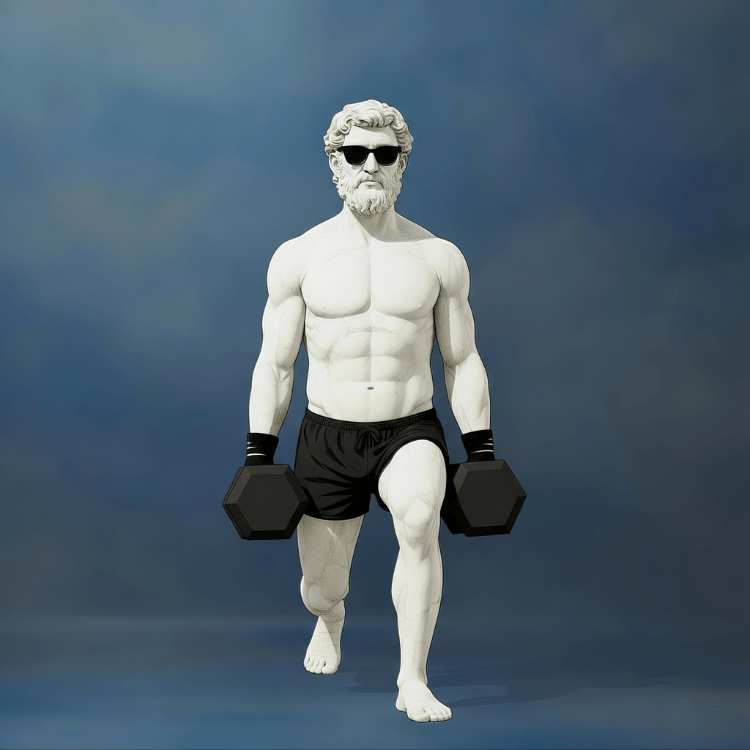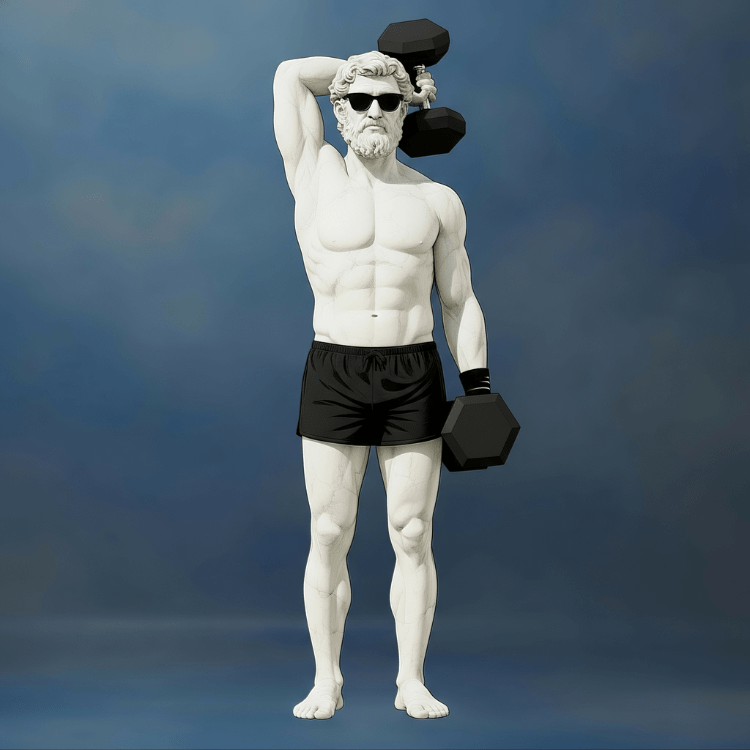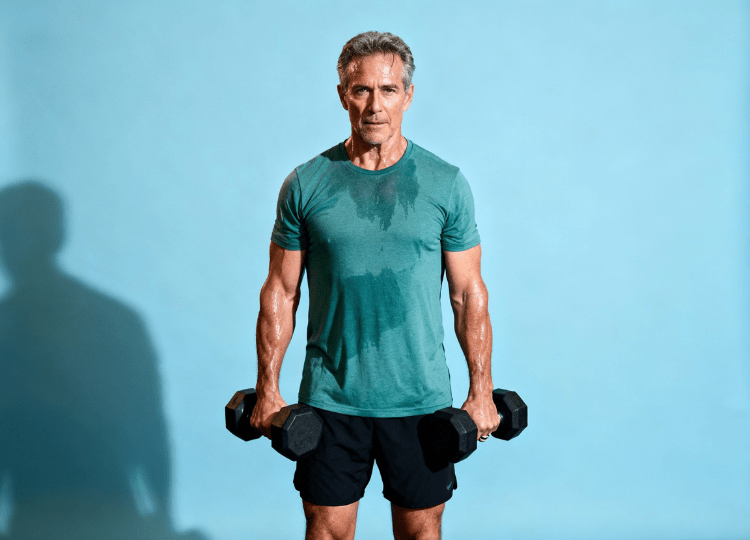If you’re over 50 and want to get stronger, feel more capable, and keep your body moving well for years to come… but you’re also not interested in spending hours at the gym, this workout is your sweet spot.
Fifteen minutes. A pair of dumbbells. Zero fuss.
This routine is designed specifically for adults over 50 who want to build muscle, support their joints, stay mobile, and feel confident in their strength. It’s low-impact, joint-friendly, and incredibly efficient… without being “easy.” You’ll work your entire body in a smart, balanced circuit that drives real progress while still respecting where your body is right now.
Whether you’re getting back into strength training or you’ve been lifting for years, this session will meet you exactly where you are.
Let’s walk through it.
This blog is in partnership with our friends at Marble Guy – a YouTube channel for easy-to-follow workouts and exercise guides.
The 15-Minute Dumbbell Workout
You’ll perform six exercises, back-to-back, 30 seconds each. That’s three uninterrupted minutes of work, followed by two minutes of rest before starting the next round. Repeat the circuit three times.
We’re not here to punish your system. We’re here to build strength with intention, protect your joints, and help your body recover well between rounds.
Here’s your lineup:
- Alternating Reverse Lunges – 30 seconds
- Lateral Raises – 30 seconds
- Bicep Curls – 30 seconds
- Deadlifts – 30 seconds
- Tricep Extensions – 30 seconds
- Bent Over Rows – 30 seconds
That’s the whole workout. Simple on paper, surprisingly effective when you commit to form and controlled movement.
Why These Exercises Matter
Every movement in this routine serves a purpose. Together, they build strength you’ll feel in everyday life… standing up from a chair, climbing stairs, carrying groceries, lifting luggage, or doing pretty much anything involving real-world strength.
Let’s break down each exercise.
1. Alternating Reverse Lunges

Reverse lunges are one of the most joint-friendly lower-body moves. Stepping back instead of forward reduces pressure on the knees while still strengthening your legs, glutes, and core.
You’re also training balance, a crucial skill that becomes more important as we age.
Why it matters: Strong legs and good balance are key for longevity, independence, and avoiding falls.
Trainer Tip: Step back with control. Keep your chest lifted and front knee aligned with your toes.
Common Mistake: Letting the front knee slide too far forward or leaning the torso excessively.
2. Lateral Raises

If you want strong, healthy shoulders, lateral raises are one of the best tools you have. They strengthen the medial deltoids… the muscles that support posture, stabilize the shoulder joint, and help with everyday tasks like lifting and carrying.
They also make your shoulders look great, but we’ll call that a bonus.
Why it matters: Shoulder strength and stability protect your joints and reduce injury risk.
Trainer Tip: Keep a slight bend in your elbows and lift only to shoulder height.
Common Mistake: Going too heavy and shrugging your shoulders upward.
3. Bicep Curls

Yes, they’re simple. Yes, they’re classic. And yes… they’re extremely useful.
Bicep curls strengthen your upper arms and grip, which supports everything from opening jars to carrying shopping bags to holding onto railings when you need them.
Why it matters: Strong biceps make daily life easier and help protect your elbows and shoulders.
Trainer Tip: Keep elbows close to your sides and move with control.
Common Mistake: Swinging the weights or using momentum.
4. Deadlifts

If there’s one movement every adult over 50 should master, it’s the deadlift. This hip-hinge pattern is the foundation of safe lifting… whether you’re picking up a laundry basket or hoisting a suitcase.
Deadlifts strengthen your entire posterior chain: glutes, hamstrings, and lower back. These muscles are the backbone of posture, stability, and pain-free movement.
Why it matters: A strong posterior chain is critical for longevity, mobility, and avoiding back pain.
Trainer Tip: Hinge at your hips, not your waist. Keep your spine neutral.
Common Mistake: Rounding the back or bending the knees too much.
5. Tricep Extensions

Your triceps make up a surprising amount of your upper-arm muscle. Strengthening them improves pressing strength, supports shoulder stability, and balances out all the curling you do for biceps.
Single-arm tricep extensions allow you to focus on form and reduce compensations.
Why it matters: Strong triceps are essential for pushing, lifting, and upper-body function.
Trainer Tip: Keep your elbow close to your head and extend fully through the movement.
Common Mistake: Flaring elbows or arching your lower back.
6. Bent Over Rows

Rows are your posture hero. They strengthen your upper back, help counteract rounding through the shoulders, and build the muscles that stabilize your spine.
You’ll also engage your core naturally as you maintain the hinge position.
Why it matters: A strong back supports your joints, reduces injury risk, and improves posture.
Trainer Tip: Keep your back flat and pull toward your ribcage.
Common Mistake: Standing too upright or jerking the weight.
Why This Circuit Works So Well
This isn’t just a random list of six exercises. The sequence is designed to give you:
Full-body strength
You hit legs, glutes, shoulders, arms, back, and core… all in three minutes.
Balanced training
Pushing muscles, pulling muscles, and stabilizing muscles all get their share.
Low-impact load
Every movement is joint-friendly, controlled, and adaptable.
Built-in recovery
Because the exercises alternate between body regions, one area rests while another works.
Functional movement patterns
You’re training skills you actually use every day:
- Squatting and lunging
- Lifting and lowering
- Pushing and pulling
- Balancing and stabilizing
A structure that encourages consistency
Fifteen minutes feels manageable, not overwhelming. And manageable means repeatable.
How to progress safely
Here are a few ways to level up the workout over time:
1. Increase the load
Once all rounds feel comfortable, go up one dumbbell size.
2. Add a fourth round
That pushes the workout to ~18 minutes of total time and adds a manageable challenge.
3. Use tempo training
Try:
- 2 seconds up, 2 seconds down
- Pause at the top of curls, rows, or deadlifts
- Slow descents to build control
4. Improve movement quality
Better posture, smoother reps, and deeper lunges make the workout harder and more effective.
5. Repeat it twice per week
Strength loves consistency. Two or three sessions per week is ideal for muscle gain and joint health.
Why You’ll Love This Workout
Beyond being time-efficient and easy to follow, this routine checks the boxes that matter most for adults 50+.
1. It builds real-world strength
From getting up off the floor to carrying bags to gardening… your body will feel more capable.
2. It’s joint-friendly
No jumping. No high-impact moves. Everything is controlled and low-stress.
3. It supports muscle and bone health
Strength training is the best tool we have for maintaining bone density, protecting joints, and keeping muscle mass as we age.
4. It boosts stability and coordination
Movements like lunges and rows challenge balance and body awareness, crucial for preventing falls.
5. It’s efficient
The whole workout is 15 minutes, rest included. That’s shorter than most TV ad breaks.
6. It fits into any home setup
Small space? No problem. No gym commute? Even better. Grab your dumbbells and start.
A Few Coaching Reminders Before You Begin
Because technique is everything:
Move with control
Fast reps don’t build better strength… controlled reps do.
Keep your core lightly braced
Imagine tightening around your waist just enough to stay stable.
Pain is not the goal
Muscle fatigue? Yes. Sharp pain? Hard no. Adjust your range of motion or lighten the weight if something feels off.
Honor your knees and back
Choose the depth and stance that feel good. Everything is modifiable.
Stay tall and breathe
Exhale on the effort, inhale on the return. It keeps your spine supported and your form clean.
Bottom Line
This full-body dumbbell circuit is everything strength training should be for adults over 50: simple, safe, effective, and sustainable. It trains the muscles that matter most for longevity, posture, balance, and everyday movement… without overwhelming your joints or stealing your entire afternoon.
Three rounds. Six movements. One pair of dumbbells.
If you’re looking for a routine that helps you get strong and stay strong at any age, this is one you’ll come back to again and again.
Related Articles:
